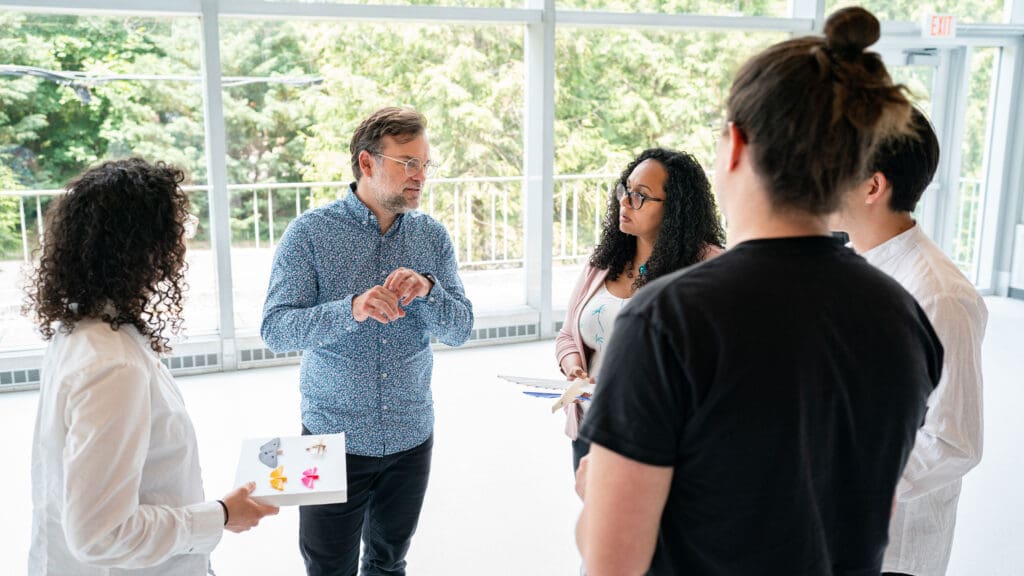The engineering school awarded more than $2.4 million in 2023 annual research grants for these and 14 other projects. Pierre-Thomas Brun, assistant professor of chemical and biological engineering, and Aimy Wissa, assistant professor of mechanical and aerospace engineering, are collaborating on the project to investigate new wing designs for gliding robots. Combining their expertise in the mechanics of soft materials and in bio-inspired flight, Brun and Wissa’s research groups are studying the structures and capabilities of grasshopper wings and flying fish fins.
Both these appendages can be deployed in milliseconds when an animal switches from jumping or swimming to gliding flight — in contrast to the fixed wings of typical gliding robots. The interdisciplinary team plans to take advantage of soft structures’ pliability to help robots make quick maneuvers.

The project builds on recent work by Brun’s group to develop soft, deployable structures using inflatable tubes, including a wing-like structure informed by the unfolding of a cicada’s wings as it sheds its shell. The innovation grant will allow the team to test different types of foldable wings and model their performance. After designing a wing that can be rapidly deployed, they will also investigate how raylike structures, similar to those in the fins of flying fish, can be manipulated to increase lift or achieve turns during gliding flight. Future work may also explore systems for actively powered flight and other modes of locomotion.
“We’re hoping to develop a framework that helps us think about designing articulated soft structures for robotics in general,” said Wissa. Beyond flying robots, any types of robots intended for human interaction could benefit from new types of soft structures, she said.
Soft robots are far safer and nimbler than the rigid structures that dominate current systems, but soft structures are difficult to control. This work will advance the ability to control soft robots, which is crucial for designing robots at small scales, said Brun.
Their collaboration is supported by the Addy Fund for Excellence in Engineering.
Princeton Engineering’s Innovation Research Grants are funded by Princeton alumni, parents and other donors. This year’s awards include:
Addy Fund for Excellence in Engineering
The Addy Fund for Excellence in Engineering was established in 2017 by Lydia B. Addy and William M. Addy, a 1982 Princeton alumnus. In addition to Pierre-Thomas Brun and Aimy Wissa, these funds were awarded to:
Maria Apostolaki, assistant professor of electrical and computer engineering, for the project “Filling the gaps in network monitoring” (also supported by the James Mi *91 Research Innovation Fund for Data Science);
Danqi Chen, assistant professor of computer science, and Kai Li, the Paul M. and Marcia R. Wythes Professor of Computer Science, for the project “Mitigating privacy risks in large language models”;
Michael Mueller, professor of mechanical and aerospace engineering, for the project “Machine learning-accelerated engineering simulations with extremely complex models”;
and Karthik Narasimhan, assistant professor of computer science, and Anirudha Majumdar, assistant professor of mechanical and aerospace engineering, for the project “Dynamic knowledge retrieval for adaptive planning in robots.”
Project X Fund
Project X funding enables Princeton engineering faculty members to pursue exploratory research geared toward “creativity, tinkering and risk-taking.” The fund is made possible by G. Lynn Shostack in honor of her late husband David Gardner, a 1969 Princeton graduate. Project X grants were awarded to:
Sigrid Adriaenssens, professor of civil and environmental engineering, and Presidential Postdoctoral Research Fellow Lucia Stein-Montalvo, for the project “Kirigami tailors airflow and shade in public, outdoor spaces”;
Christine Allen-Blanchette, assistant professor of mechanical and aerospace engineering and statistics and machine learning, for the project “Discovering the structure of mechanical systems from video”;
Elie Bou-Zeid, professor of civil and environmental engineering, for the project “Machine learning for understanding and forecasting urban heat islands”;
and Saien Xie, assistant professor of electrical and computer engineering and the Princeton Materials Institute, for the project “Mechanically reconfigurable optoelectronic devices.”
Tianaderrah Foundation
Grants from the Tianaderrah Foundation were awarded to:
José Avalos, associate professor of chemical and biological engineering and the Andlinger Center for Energy and the Environment, for the project “Nanobody-enabled proteomic engineering for basic research and biotechnology”;
and Sujit Datta, assistant professor of chemical and biological engineering, Jason Fleischer, professor of electrical and computer engineering, and Tian-Ming Fu, assistant professor of electrical and computer engineering and the Princeton Bioengineering Initiative, for the project “Optical tomography of fluid flow in packed beds.”
Helen Shipley Hunt Fund
Made possible by Helen Shipley Hunt, who earned a master’s degree in mathematics from Princeton in 1971, this fund supports research aimed at improving human health, with a focus on applied projects. Shipley Hunt funds were awarded to:
Ben Raphael, professor of computer science, for the project “Machine learning approaches for quantifying spatial gene expression in tissues”;
and Mona Singh, the Wang Family Professor in Computer Science, for the project “Computational methods to discover genes associated with complex diseases.” Singh’s project is also supported by the Forese and O’Brien funds for innovative research in human health.
Additional Engineering Research Funds
Jonathan Conway, assistant professor of chemical and biological engineering, was awarded funds for the project “Characterizing lignocellulose-degrading enzymes for industrial biofuel applications.” His project is supported by the Wilke Fund for Innovation and funds from an anonymous donor.
Jürgen Hackl, assistant professor of civil and environmental engineering, will pursue the project “System-level infrastructure resilience in a changing climate” with support from the J. Ricardo Poma ’67 P94 Fund for Excellence in Engineering.
Paul Prucnal, professor of electrical and computer engineering, received support from the Samberg Family Fund for Innovative Engineering for the project “Neuromorphic photonic OLED platform for augmented reality.”
With Yasaman Ghasempour, assistant professor of electrical and computer engineering, Prucnal also received funding for the project “Silicon photonic AI chips for real-time terahertz communications.” This project is supported by a fund established in memory of J. Insley Blair Pyne, a physics and electrical engineering professor and Princeton graduate, to advance research at the intersection of engineering and neuroscience.

































